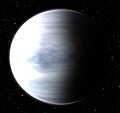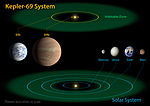Kepler-1708b (previously known as KIC 7906827.01) is a Jupiter-sized exoplanet orbiting the Sun-like star Kepler-1708, located in the constellation of...
13 KB (1,198 words) - 17:45, 28 June 2024
exhibits higher systematics that may explain their differing conclusions. Kepler-1708b PDS 70 2MASS J11193254–1137466 AB Subsatellite V1400 Centauri Chou, Felicia;...
7 KB (600 words) - 04:26, 29 July 2024
Kepler-186 is a main-sequence M1-type dwarf star, located 177.5 parsecs (579 light years) away in the constellation of Cygnus. The star is slightly cooler...
17 KB (1,539 words) - 04:15, 18 July 2024
Kepler-22 is a Sun-like star in the northern constellation of Cygnus, the swan, that is orbited by a planet found to be unequivocally within the star's...
10 KB (659 words) - 10:59, 9 May 2024
Kepler-452 is a G-type main-sequence star located about 1,810 light-years away from Earth in the Cygnus constellation. Although similar in temperature...
13 KB (1,189 words) - 08:01, 9 May 2024
December 2023 — The exomoon candidate around Kepler-1625b was again challenged, along with the Kepler-1708b candidate. This study argues that the statistical...
27 KB (2,211 words) - 16:12, 29 July 2024
orbiting it. Kepler-289 hosts four planets, three confirmed (Kepler-289b, Kepler-289c, Kepler-289d) and one unconfirmed candidate (Kepler-289e). The discovery...
6 KB (376 words) - 09:35, 9 May 2024
Kepler-385 (also designated KOI-2433) is an F-type main-sequence star located about 4,900 light-years (1,500 parsecs) away from Earth in the constellation...
7 KB (464 words) - 22:21, 22 March 2024
Kepler-1625b is a super-Jupiter exoplanet orbiting the Sun-like star Kepler-1625 about 2,500 parsecs (8,200 light-years) away in the constellation of...
11 KB (1,060 words) - 19:29, 27 June 2024
Kepler-1649b is a Venus-like exoplanet orbiting Kepler-1649. Kepler-1649 is a type-M red dwarf star estimated to be roughly ¼ the radius of the Sun with...
2 KB (144 words) - 20:12, 24 May 2024
from the Kepler space telescope and confirmed in 2015. None of the planets orbit within the habitable zone. Kepler-445b, c, and d orbit Kepler-445 every...
6 KB (348 words) - 02:01, 27 September 2023
Kepler-70, also known as KIC 5807616 and KOI-55, is a star about 3,600 light-years (1,100 parsecs) away in the constellation Cygnus, with an apparent visual...
12 KB (1,094 words) - 21:13, 3 February 2024
Kepler-443b is an exoplanet about 2,540 light-years from Earth. It has an 89.9 percent chance of being in the star's habitable zone, yet only a 4.9 percent...
4 KB (273 words) - 20:32, 20 January 2024
Kepler-1649c is an Earth-sized exoplanet, likely rocky, orbiting within the habitable zone of the red dwarf star Kepler-1649, the outermost planet of...
10 KB (885 words) - 21:09, 14 January 2024
Kepler-1658b (or the Kepler object of interest, KOI-4.01) is a hot Jupiter, a type of gas giant exoplanet, that orbits an F-type star called Kepler 1658...
13 KB (1,262 words) - 05:28, 29 July 2024
Kepler-409b is a super-Earth orbiting Kepler-409, a G-type main-sequence star. Its orbital period around the star is 69 days. Kepler-409b has a radius...
3 KB (262 words) - 13:27, 2 May 2024
Kepler-11, also designated as 2MASS J19482762+4154328, is a Sun-like star slightly larger than the Sun in the constellation Cygnus, located some 2,110...
18 KB (1,536 words) - 04:13, 18 July 2024
Kepler-283c is an exoplanet orbiting the K-type star Kepler-283 every 93 days in the circumstellar habitable zone, discovered by the Kepler space telescope...
4 KB (205 words) - 11:03, 16 June 2024
two planets announced are designated Kepler-47b, and Kepler-47c, and the third, later discovery is Kepler-47d. Kepler-47 is the first circumbinary multi-planet...
22 KB (2,132 words) - 06:23, 22 December 2023
Kepler-69 (KOI-172, 2MASS J19330262+4452080, KIC 8692861) is a G-type main-sequence star similar to the Sun in the constellation Cygnus, located about...
9 KB (688 words) - 20:53, 28 June 2024
Kepler-737b is a super-Earth exoplanet 669 light years away. There is a chance it could be on the inner edge of the habitable zone. Kepler-737b is an exoplanet...
11 KB (1,244 words) - 09:02, 21 April 2024
Kepler-36 is a star in the constellation of Cygnus with two known planets. It has an anomalously large radius, meaning that it is a subgiant. On June 21...
6 KB (353 words) - 17:50, 3 May 2024
Kepler-16 is an eclipsing binary star system in the constellation of Cygnus that was targeted by the Kepler spacecraft. Both stars are smaller than the...
9 KB (489 words) - 10:30, 9 May 2024
Kepler-451 (also known as 2MASS J19383260+4603591 and abbreviated to 2M1938+4603) is an eclipsing post-common envelope binary star system that comprises...
7 KB (498 words) - 04:26, 29 July 2024
Kepler-5 is a star located in the constellation Cygnus in the field of view of the Kepler Mission, a NASA project aimed at detecting planets in transit...
13 KB (1,064 words) - 20:06, 9 March 2024
Kepler-87 hosts four planets, two confirmed (Kepler-87b, Kepler-87c and two unconfirmed (Kepler-87d, Kepler-87e). It is the farthest system from the Sun...
3 KB (150 words) - 01:11, 29 April 2024
This is a partial list of exoplanets discovered by the Kepler space telescope, running from star number 1501 through 2000, inclusive. All lists: 1–500...
22 KB (267 words) - 07:54, 22 May 2024
Kepler-1652b (also known by its Kepler Objects of Interest designation KOI-2626.01) is a super-Earth exoplanet, orbiting within the habitable zone of the...
7 KB (772 words) - 11:10, 16 June 2024
Kepler-1625 is a 14th-magnitude solar-mass star located in the constellation of Cygnus approximately 7,200 light-years (2,200 parsecs) away. Its mass is...
11 KB (987 words) - 10:48, 11 March 2024
Kepler-371 (also known as KOI-2194 or KIC 3548044) is a star some 2,680 ly away from the Earth. It hosts a multi planetary system consisting of 2 confirmed...
3 KB (159 words) - 07:32, 16 June 2024









